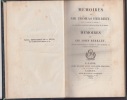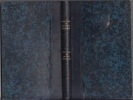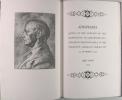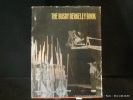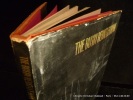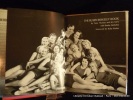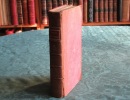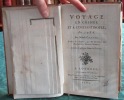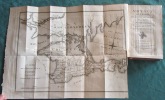154 books for « berkeley m »Edit
-
Language
English (2)
French (152)
Italian (1)
-
Century
18th (10)
19th (8)
20th (88)
21st (1)
-
Countries
Belgium (6)
Canada (1)
Denmark (2)
France (141)
Switzerland (4)
United Kingdom (1)
-
Syndicate
ALAC (1)
CLAQ (1)
ILAB (88)
SLAM (84)
Topics
- Abraham (1)
- Alchemy (1)
- Anticlerical (1)
- Atheism (1)
- Berkeley (146)
- Books from the xviiith (1)
- Constantinople (1)
- Crimea (2)
- Drawings (1)
- Earth (1)
- Economics (1)
- England (3)
- Epistemology (2)
- Ethic (1)
- Europe (1)
- Fine arts (2)
- First edition (2)
- Germany (1)
- Great britain (1)
- Guittoneau ben (1)
- History (8)
- Industrial arts & crafts - fine arts (1)
- Ireland (2)
- Jazz (1)
- Literature (1)
- Magazine (1)
- Memories (1)
- Menard alias colin de lafferierre (1)
- Middle ages (1)
- Military arts (1)
- Mushrooms mycology (1)
- Music magazines (1)
- Newspapers press (1)
- pharmacy (1)
- Philosophy (3)
- Photography (1)
- Portraits (1)
- Review (1)
- Reviews (1)
- Sail (1)
- Solomon (1)
- Tea (1)
- Theology (1)
- Turkey - ottoman empire (2)
- United kingdom (3)
Oeuvres IV : Le questionneur et Siris.
PUF Epiméthée 1996 PUF, Coll. Epiméthée, 1996, 362 p., broché, environ 22x15cm, avec un envoi de la traductrice, bon état et intérieur très propre.
Traduction de Roselyne Dégremont. Merci de nous contacter à l'avance si vous souhaitez consulter une référence au sein de notre librairie.
Three Dialogues between Hylas and Philonous. The Design of which Is plainly to demonstrate the Reality and Perfection of Humane Knowledge, the Incorporeal Nature of the Soul, and the Immediate Providence of a DEITY: In Opposition to Sceptics and Athei... - [THE PERCEPTUAL RELATIVITY]
London, Printed by G. James, for Henry Clements, 1713. 8vo. Contemporary marbled full calf boards, prettily rebacked in period style with gilt title-label, raised bands and gilt ornamentations to spine. During the re-backing, new end-papers have been inserted, but the original front end-paper , containing old owners' inscriptions, has been preserved and is still withbound. Three old owners' names to title-page, two of them crossed out. The title-page had been repaired at the outer margin, affecting three letters in the last three lines of the subtitle (To open a Method for rendering the/ SCIENCES more easy, useful, and/ compensious), namely the ""he"" in ""the"" and the ""d"" in ""and"" as well as part fo the double-ruled border, which has been drawn up again. The final leaf with a somewhat crode repair causing loss of some words towards the hinge. A small hole in A3, not repaired. A bit of brownspotting, mostly at beginning and end. With its flaws, still and overall acceptable copy of this extremely rare title. (10), 166 pp.
The very scarce first edition of Berkeley's other magnum opus, his great work of metaphysics, second in importance only to his ""Treatise Concerning the Principles of Human Knowledge"" (1710). The present work is not only a popularized version of the ""Treatise"", though it is a fact that it was more widely studied and more easily understood - being written as an almost Platonian dialogue between Hylas (Greek for ""matter"" - thought to be the representative for John Locke) and Philonous (Greek for ""the lover of reason"" - Berkeley's spokesman) - it also constitutes a thorough and elaborated explanation of Berkeley's central ideas and the emergence of many of the principal thoughts that we now associate with him and his anti-materialist philosophy.""In this Treatise, which does not presuppose in the Reader, any Knowledge of what was contained in the former (i.e. the ""Treatise""), it has been my Aim to Introduce the Notions I advance, into the Mind, in the most easy and familiar manner" especially, because they carry with them a great Opposition to the Prejudices of Philosophers, which have so far prevailed against the common Sense and natural Notions of Mankind.If the principles, which I here endeavour to propagate, are admitted true" the Consequences which, I think, evidently flow from thence, are, that Atheism and Scepticism will be utterly destroyed, many intricate Points made plain, great Difficulties solved, several useless Parts of Science retrenched, Speculation referred to Practise, and Men reduced from Paradoxes to common Sense"" (Preface, pp. (7-8)).In the present work, Berkeley, one of the greatest thinkers of early modern philosophy, sets out to alter the direction of philosophy and set straight the boundaries of man's knowledge of himself and the world around him. He seeks to bring back man to common sense and to bring back science and knowledge to that which is essential and factual. In the present work he famously defends the idealism, because of which he is still considered one of the greatest metaphysicians ever. As his ""Treatise"" is remembered today for the famous phrase ""Esse est percipi"" - to be is to be perceived - so his ""Dialogues"" is remembered for the introduction of the perceptual relativity argument (stating that the same object can have different characteristics, e.g. shape, colour, etc., depending on the perspective of the observer, e.g. distance, angle, light, etc.). Furthermore, as Berkeley had used God in the ""Principles"" as the CAUSE or originator of our ideas of sense, in the ""Dialogues"" he brings God a very important step further, stating that our ideas must EXIST IN God when not perceived by us, thus seeing this as the warrant for the continuity of our ideas (God being unchanging). This leap (from claiming that God must cause our ideas to claiming that our ideas must exist in God) that Berkeley thus takes in the ""Dialogues"" is among the most important within his philosophy, guaranteeing continuous existence to physical objects. The work is considered the foremost representative of Berkeley's phenomenalism.""George Berkeley, Bishop of Cloyne, was one of the great philosophers of the early modern period. He was a brilliant critic of his predecessors, particularly Descartes, Malebranche, and Locke. He was a talented metaphysician famous for defending idealism, that is, the view that reality consists exclusively of minds and their ideas. Berkeley's system, while it strikes many as counter-intuitive, is strong and flexible enough to counter most objections. His most-studied works, the Treatise Concerning the Principles of Human Knowledge (Principles, for short) and Three Dialogues between Hylas and Philonous (Dialogues), are beautifully written and dense with the sort of arguments that delight contemporary philosophers. He was also a wide-ranging thinker with interests in religion (which were fundamental to his philosophical motivations), the psychology of vision, mathematics, physics, morals, economics, and medicine. Although many of Berkeley's first readers greeted him with incomprehension, he influenced both Hume and Kant, and is much read (if little followed) in our own day."" (SEP).Berkeley published his first important philosophical work, ""Essay Toward a New Theory of Vision"" in 1709, aged 24. The book was well-received and a second edition came out later that same year. The following year he published ""A Treatise Concerning the Principles of Human Knowledge"" , in which he sought to lay out a complete philosophical system based on the idea that the only existing entities in the world are ideas and the mind that perceives them. The work was not very well received, however. This did not affect his search for truth, though, and he continued the outlay of his philosophical system in his ""Three Dialogues between Hylas and Philonous"", which was printed in 1713. Though neither of the two works were well received and appeared in small numbers, they are by far the most important and enduring of all of his works. The view that he presents in the ""Dialogues"" is that which he called ""immaterialism"" (now ""idealism""). He considered this anti-materialism the perfect answer to and refutation of skepticism and atheism, and his theories later became the foundation of much idealistic philosophy.""Upon the common Principles of Philosophers, we are not assured of the Existence of Things from their being perceived. And we are taught to distinguish their real Nature from that which falls under our Senses. Hence arise Scepticism and Paradoxes. It is not enough, that we see and feel, that we taste and smell a thing. Its true Nature, its absolute external Entity, is still concealed. For, tho it be the Fiction of our own Brain, we have made it inaccessible to all our Faculties. Sense is fallacious, Reason defective. We spend our Lives in doubting of those things which other Men evidently know, and believing those things which they laugh at and despise..."" (Preface, p. (6)).The first edition of this important work is very difficult to find. It was published in an edition together with the ""Treatise"" in 1734, which, though also scarce, is the edition of the work that most libraries and institutions have in their holdings, seeing that the first editions of both works are of even greater scarcity. We have only been able to locate three copies in libraries worldwide.
Recherches sur les vertus de l'eau de goudron où l'on a joint des réflexions philosophiques sur divers autres sujet. Traduit de l'anglais par M. Boullier avec deux lettres de l'auteur -- PREMIERE EDITION FRANCAISE EN PARTIE ORIGINALE PUBLIEE EN 1745 A AMSTERDAM
Amsterdam, Mortier, 1745, un volume in 12 relié en plein veau, dos orné de fers dorés, tranches rouges (reliure de l'époque), (petit accroc à la coiffe, coins émoussés, 24pp., 343pp.
---- PREMIERE EDITION FRANCAISE EN PARTIE ORIGINALE de l'ouvrage de BERKELEY paru dans sa version anglaise sous titre de "Siris". Cette édition française a été AUGMENTEE DES ADDITIONS ET CORRECTIONS COMMUNIQUEES PAR G. BERKELEY à M. BOUILLIER AVANT QU'IL N'ENTREPRENNE SA TRADUCTION ---- Ex libris Jean-René CLERGEAU ---- "The close interweaving of science with epistemology, as well as of metaphysics with theology, is very prominent in BERKELEY's last major work, Siris, which begins as an investigation of the medicinal virtues of tar water and ends with a disquisition on platonic philosophy. The body of the book consists, on the one hand, of a discussion of contemporary chemical theory and, on the other, of a critique of newtonian principles of explanation, of space and time and of the true interpretation of the concept of causation. The sections on chemistry are of particular interest, for they display considerable acquaintance with most of the major chemical doctrines of BERKELELY's period (e.g., Boerhaave, Homberg, Hales, Lemery, etc.), including a discussion of acids, salts, alkalies and air that leads to a discussion of fire and light, the latter providing a "bridge" to a spiritual interpretation of all phenomena. Siris thus involves an attempt to assimilate newtonian concepts to the pre complex phenomena of chemistry and animal physiology... BERKELEY's general influence extended to such writters as HUME, MACLAURIN and KANT in the eighteenth century and MILL, HELMHOLTZ and MACH in the nineteenth. He also anticipated many of the ideas of twentieth-century philosophers of science". (DSB II pp. 16/18) ---- Heirs of Hippocrates N° 805 & Cole N° 113 (english ed.) - Partington II p. 506**394(00).o3
RECHERCHES SUR LES VERTUS DE L'EAU DE GOUDRON, où l'on a joint des réflexions philosophiques sur divers autres sujets, traduit de l'anglais du Dr George Berkeley... (par D.-R. Boullier.) Avec deux lettres de l'auteur
Amsterdam Pierre Mortier 1745 in-12 plein-veau reliure plein veau havane in-douze (binding full calfskin duodecimo) (17 x 10,6 cm), dos 5 nerfs (spine with raised bands), décoration "or" et à froid (gilt and blind stamping decoration), titre frappé "or", pièce de titre sur fond maroquin bordeaux avec filet "or" en encadrement, roulette "or" en place des nerfs et en tête et en pied, entre-nerfs à fleuron "or" dans un encadrement d'un filet "or" avec rinceaux aux angles, nerfs légèrement frottés avec dorure légèrement estompée sur 3 nerfs ( blurred gilding), roulette "or" sur les coupes, toutes tranches lisses jaspées rouges (red edges), texte à manchette (marginal note), sans illustrations, XXIV + 343 pages , 1745 à A Amsterdam Chez Pierre Mortier Editeur,
PREMIERE EDITON FRANCAISE EN PARTIE ORIGINALE de l'ouvrage de Berkeley paru dans sa version anglaise sous titre de "SIRIS". Cette édition française a été AUGMENTEE DES ADDITIONS ET CORRECTIONS COMMUNIQUEES PAR G. BERKELEY A M. BOUILLIER AVANT QU'IL N'ENTREPRENNE SA TRADUCTION ....... L'eau de goudron était un médicament utilisé depuis le Moyen Âge composé de goudron de pin ou de bouleau. Son utilisation se répandit au XVIIIe en Angleterre. Berkeley décrit pour la première fois son utilisation dans une large variété de cas et se demande si ce n'est pas la panacée universelle. Il extrapole quant à son efficacité à partir d'une étude de l'esprit et de l'âme dont l'ether serait l'instrument divin et la chose qui lie les êtres entre eux. L'eau de goudron, sera utilisée sous diverses formes jusqu'à la fin du XIXe. Bergson appréciait particulièrement les qualités philosophiques du traité.......RARE...en bon état (good condition). bon état
Alciphron, ou Le petit philosophe ; en sept dialogues; Contenant une Apologie de la Religion Chrétienne contre ceux que l'on nomme Esprits-Forts.
2 volumes in-12 (168 x 98 mm), plein vélin rigide de l'époque, dos titrés à la plume, (8), 372, (10) p. et (2), 218, (6), 133, (15) p., planche gravée dépliante de figures géométriques au tome I. La Haye, P. Gosse & J. Neaulme, 1734.
Première traduction française, par lencyclopédiste Elie de Joncourt, d "Alciphron, or the Minute Philosopher", que Berkeley composa en 1729 à Newport (Rhode Island), ce qui en fait le premier ouvrage philosophique dimportance rédigé en Amérique du Nord. "Alciphron reprend le projet pascalien d'une apologie de la religion chrétienne contre ses critiques modernes. D'une haute tenue littéraire, l'uvre est imitée des dialogues platoniciens. Parmi les quelques intellectuels qui s'y sont risqués depuis la Renaissance, Berkeley est un de ceux qui se sont le plus brillamment acquittés de cette tâche" (Pierre M. Bellemare, Univ. du Québec).Pour les historiens des idées, louvrage possède une valeur considérable également par le débat quil suscita sur la question du déisme, en Angleterre avec Shaftesbury, Hobbes, Toland, Tindal, Collins, Mandeville, comme en France à travers Voltaire et ses détracteurs.Contient, en fin du second volume: "Essay sur une nouvelle théorie de la vision" ("Nouvelle théorie de la vision défendue et expliquée"), en pagination séparée.(France Littéraire, I, 286. Jessop, 'A Bibliography of Berkeley', 126b. Rochedieu, 'Bibliogr. of French translations of English works', 22).Papier uniformément bruni.Exemplaire bien relié en vélin rigide à lépoque.


Phone number : 33 01 47 07 40 60
Recherches sur les vertus de l'eau de goudron
Chez Pierre Mortier | à Amsterdam 1747 | 10 x 17 cm | relié
Edition originale. L'édition française a été augmentée des additions et correction communiquées par Berkeley à Bouillier avant qu'il n'entame sa traduction. Page de titre en rouge et noir. Reliure en pleine basane moucheté brune d'époque. Dos à nerfs richement orné, roulette en queue. Pièce de titre en maroquin rouge. Coiffe de tête arrachée. Coiffe de queue élimée. Mors fendus en tête et queue. 2 trous de vers sur le dos. Petit grignotage au dernier feuillet en marge haute sur moins d'un cm. Assez bon exemplaire. L'eau de goudron était un médicament utilisé depuis le Moyen Âge composé de goudron de pin ou de bouleau. Son utilisation se répandit au XVIIIe en Angleterre. Berkeley décrit pour la première fois son utilisation dans une large variété de cas et se demande si ce n'est pas la panacée universelle. Il extrapole quant à son efficacité à partir d'une étude de l'esprit et de l'âme dont l'ether serait l'instrument divin et la chose qui lie les êtres entre eux. L'eau de goudron, sera utilisée sous diverses formes jusqu'à la fin du XIXe. Bergson appréciait particulièrement les qualités philosophiques du traité. - Photographies et détails sur www.Edition-Originale.com -


Phone number : 01 56 08 08 85
Recherches sur les vertus de l'eau de goudron..., traduit de l'anglois
Amsterdam Pierre Mortier 1745
in-12, xxiv et 343p. :: Edition originale de la traduction du dernier livre de Berkeley paru dans sa version anglaise sous le titre de ''Siris''. :: L'eau de goudron est un médicament du Moyen Age décrit au XVIIIe siècle Par George Berkeley et utilisé jusqu'au début du XXe siècle. Dès le début du XIXe, des critiques apparaissent sur l'efficacité thérapeutique du produit. L'eau de goudron est l'un des sujets qui passionna le monde des Lumières. :: Reliure de l'époque, basane, dos orné, 5 nerfs, tranches rouges. Coins frottés, coiffe de tête limée. Intérieur frais.
Revue d'Histoire des Sciences - François de Gandt sur Newton - Michel Blay sur Michel Rolle et George Berkeley - Sylvain Zac sur Salomon Maïmon - Charles C. Gillispie - Pierre Costabel sur Kurt Vogel
Reference : 101030
(1986)
Revue d'Histoire des Sciences - Tome 39 (XXXIX), n° 3 - Juillet - Septembre 1986 - Etudes sur l'histoire du calcul infinitésimal , (Le style mathématique des Principia de Newton - Deux moments de la critique du calcul infinitésimal : Michel Rolle et George Berkeley - Noumène et différentielle dans la philosophie de Salomon Maïmon - Le Fonds Seguin à Privas - Kurt Vogel)
Presses Universitaires de France - P.U.F. , Revue d'Histoire des Sciences Malicorne sur Sarthe, 72, Pays de la Loire, France 1986 Book condition, Etat : Moyen broché, sous couverture imprimée éditeur blanche, titre en bleu et noir grand In-8 1 vol. - 93 pages
quelques figures dans le texte en noir et blanc 1ere édition, 1986 Contents, Chapitres : 1. Articles : 1.1. François de Gandt : Le style mathématique des Principia de Newton - 1.2. Michel Blay : Deux moments de la critique du calcul infinitésimal : Michel Rolle et George Berkeley - 1.3. Sylvain Zac : Noumène et différentielle dans la philosophie de Salomon Maïmon - 2. Documentation : Charles C. Gillispie : Le Fonds Seguin à Privas - 3. Nécrologie : Pierre Costabel : Kurt Vogel, 1888-1985 - 4. Informations, analyses Le haut de la couverture est un peu gondolé, tâche sombre sur la tranche supérieur affectant le haut des pages, principalement la marge supérieure, le texte reste propre, papier légèrement jauni, cela reste un bon exemplaire de lecture - paginé 196 à 288
Recherches sur les vertus de l’eau de goudron. Où l’on a joint des Réflexions Philosophiques sur divers autres sujets importans. Traduit de l’Anglois du Docteur George Berkeley, évêque de Cloyne. Avec deux lettres de l’auteur
Amsterdam, Pierre Mortier 1745 In-12 10,5 x 17,5 cm. Reliure de l’époque pleine basane fauve marbrée, dos à 5 nerfs, caissons ornés de fers dorés, pièce de titre maroquin rouge, XXIV + 343 pp. L'eau de goudron, médicament du Moyen Âge, décrite par George Berkeley fut utilisée jusqu'au début du XXe s. Coiffes usées, coins usés, première charnière fendillé, épidermures sur les plats, intérieur jauni.
Mauvais état d’occasion
Histoire de la maladie des pommes de terre en 1845 - Observations, botanical and physiological, on the potato murrain, by Rev. M. J. Berkeley - Note sur les acariens, les myriapodes, les insectes et les helminthes observés jusqu'ici dans les pommes de terre malades, par M. Guerin-Meneville -On a form of scab in potatoes, by Rev. M. J. Berkeley
Paris, librairie agricole de Dusacq, 1846, un volume in 8 cartonné, 127 pages, avec à la suite les différentes brochures citées. 6 planches dont une en couleurs. Envois manuscrits de deux auteurs. On joint "nouvelles instructions pratiques sur la culture d ea pomme de terre" de janvier 1868. Exemplaire avec des rousseurs à certaines pages, coins émoussés, petits manques à la coiffe supérieure. Exemplaire convenable et rare.
Mémoires de Sir Thomas Herbert, valet de chambre de Charles Ier, sur les deux dernières années du règne de ce prince Mémoires de Sir John Berkley, sur les négociations de Charles Ier avec Cromwell et l'armée parlementaire,introduction de François Guizot
Paris,Rouen, Béchet aîné,1823,Collection des Mémoires relatifs à la Révolution d'Angleterre 26,Collection accompagnée d'éclaircissements et pièces historiques, précédée de notices biographiques par François Guizot.1 vol.IN8 reliure demi chagrin,dos titré, (XIII-240 p.) ; 21 cm.
bon etat Remise de 20% pour toutes commandes supérieures à 200 €
BERKELEY UPDIKE D., PURINGTON ROLLINS C., MILLS IVINS Jr., ROGERS B. & WATSON KENT Henry
Reference : 16378
Addresses at the opening of the exibition of Metropolitan Museum printing held in the Pierpont Morgan Library 24 October 1938
New York, 1939. Plaquette reliure toile, titre doré sur le dos, frontispice, 27 pages., 1 f. Exemplaire numéroté (21/50) impression à l’Université de Yale par George T. Bailey pour le Columbiad Club of Connecticut. Sur papier vergé. Excellent état.
Discours prononcés à l’ouverture de l’exposition sur les impressions du Metropolitan Museum of Art (New York) sous la direction de Mr Henry WATSON KENT d’octobre à novembre 1938, à l’attention des membres d’Institut Américain des Arts Graphiques.8vo thin brochure in cloth binding, [5], 27 p., [1]. Mint and rare copy (n°21/50).Adresses given at the opening of the exhebition of Metropolitan Museum printing held in the Pierpont Morgan Library on 24 october 1938, New York (delivered by Berkeley Updike, Purington Rollins, Mills Ivins, Rogers, Watson Kent.
Trois dialogues entre Hylas et Philonous - Avec un essai critique sur Berkeley : Le langage de la nature , par Michel Ambacher - Traduit par A. Leroy, avec présentation et commentaires
Broché bon état.Contenu propre . Couverture légèrement érodée . 1970. 236 pages.PHOTOS SUR DEMANDE
Merci de nous contacter à l'avance si vous souhaitez consulter une référence dans notre boutique à Authon-du-Perche.
Recherches sur les vertus de l'eau de goudron, où l'on a joint quelques réflexions philosophiques sur divers autres sujets
Amsterdam, Pierre Mortier, 1745, in-12, XXIV-343 pp, Basane marbrée havane, dos à nerfs orné de caissons dorés, tête rouge, Édition originale de ce traité. George Berkeley était évêque de Cloyne en Irlande. Entre autres vertus de cette "eau de goudron", l'auteur donne celle qu'il avait éprouvée lui-même contre la colique nerveuse. Minuscules épidermures, quelques rares taches et rousseurs, galeries de ver sans atteinte. Blake, 43. Wellcome, II, 149. Étiquette et tampons ex-libris de l'Institut catholique. Couverture rigide
Bon XXIV-343 pp.
Le gibet imprévu
La maitrise du livre L'empreinte, L'Empreinte-Police Broché 1948 "Format poche (11,5*17,5 cm.), broché, 249 pages, N°22 de la collection L'Empreinte, reprise du numéro 50 de la collection d'origine. L'Empreinte est une collection spécialisée dans le roman policier, publiée entre 1932 et 1940 par la Nouvelle Revue Critique sous la direction d'Alexandre Ralli, elle compte 183 numéros. Elle se consacre pour l'essentiel à la fine fleur des romans policiers britanniques. Jugée comme l'une des meilleures collections de l'époque, elle reparaîtra sous le nom L'Empreinte-Police entre 1946 et 1949, aux éditions ""La Maitrise du livre"" , pour 35 numéros (dont 17 reprises d'oeuvres de la précédente collection). Anthony Berkeley Cox (1893-1971) est un écrivain britannique de roman policier. Mors un peu usés, quelques pliures et déchirures sur le dos, intérieur frais,assez bon état général. Livraison a domicile (La Poste) ou en Mondial Relay sur simple demande."
TROIS DIALOGUES ENTRE HYLAS ET PHILONOUS-AVEC UN ESSAI-CRITIQUE SUR BERKELEY: LE LANGAGE DE LA NATURE PAR MICHEL AMBACHER
COLLECTION LA PHILOSOPHIE EN POCHE-TRADUIT PAR A.LEROY, AVEC PRESENTATION, COMMENTAIRES ET PRECEDES D'UN ESSAI CRITIQUE SUR LA PHILOSOPHIE DE BERKELEY-236 PAGES-11,5 CM X 17,5 CM-(19A)
AUBIER MONTAIGNE COUVERTURE SOUPLE ETAT NEUF
Oeuvres choisies de Berkeley, Tome 1 + 2 - Collection Bibliothèque philosophique (2 volumes).
Montagne / Aubier. 1944. In-8. Broché. Etat d'usage, Couv. légèrement pliée, Dos plié, Quelques rousseurs. 382 + 300 pages - papier jauni, rousseurs sur les plats du Tome 2, accro sur le dos du Tome 2, coins frottés, pages non coupées sur le Tome 2, 2e plat partiellement désolidarisé sur le Tome 2.. . . . Classification Dewey : 190-Philosophie occidentale moderne
Collection Bibliothèque philosophique. Tome 1: Cahiers de notes - Essai d'une théorie nouvelle de la vision - Principes de la connaissance humaine (texte anglais en regard) - Obéissance passive (extraits). Tome 2: Les trois dialogues entre Hylas et Philonous (texte anglais en regard) - Alciphron (extraits) - Siris (extraits). Classification Dewey : 190-Philosophie occidentale moderne
Tony Thomas and Jim Terry, with Busby Berkeley. Foreword by Ruby Keeler
Reference : 57434
(1973)
The Busby Berkeley Book
Paris, New York Graphic Society Ltd, 1973, in-4, relié-jaquette éditeur, 184 pages. Frottements sur la jaquette sinon bon exemplaire.
NB Le délai d'acheminement vers la France est de 48h.
Mémoires de la Margrave d'Anspach. écrits par elle-même ; contenant les observations recueillies par cette princesse dans les diverses cours de l'Europe, ainsi que des anecdotes sur la plupart des princes et autres personnages célèbres de la fin du XVIIIe siècle ; traduits de l'anglais par J. T. Parisot ; ornés de portraits
Paris, Arthus Bertrand [Imprimerie de Firmin Didot], 1826 2 vol. in-8, [2] ff. n. ch., 391 pp. ; [2] ff. n. ch., 305 pp., avec 2 portraits hors texte, demi-chagrin cerise, dos à nerfs ornés de pointillés, caissons et fleurons dorés, têtes dorées (reliure de la fin du XIXe siècle).
Édition originale de la première traduction française. Ce n'est qu'en octobre 1791 qu'Elizabeth Berkeley (1750-1828), veuve du baron Craven, put épouser son vieil amant Charles-Alexandre de Brandebourg (1736-1806), qui fut le dernier margrave d'Anspach (1757-1791, où il succéda naturellement à son père), comme de Bayreuth (1769-1791, par héritage de son oncle Frédéric-Christian). En 1791, ces deux principautés enclavées en terre bavaroise furent vendues à Frédéric-Guillaume II de Prusse comme chef de la famille. Charles-Alexandre abdiqua le 2 décembre contre une rente annuelle de 300 000 florins. "Ebenbürtigkeit" obligeant, lady Craven n'eut jamais droit dans l'Empire au titre de margrave ; ce n'est qu'en Angleterre, que, par courtoisie, le couple a été généralement connu sous le nom de "margrave et margravine de Brandebourg-Ansbach".Vignette ex-libris Le Proux contrecollée sur les premières gardes. Il s'agit de Fernand-Louis-Arnould Le Proux (1844-1875), archiviste-paléographe. S'intéressant surtout à l'histoire du Vermandois, sa région natale, c'est tout naturellement qu'il intégra la Société académique de Saint-Quentin. - - VENTE PAR CORRESPONDANCE UNIQUEMENT
A reprint of economic tracts edited by Jacob H. Hollander. Several queries proposed to the public..
Baltimore, The Lord Baltimore press, 1910 in-8, 116 pp., broché. Dos défraîchi.
Réédition de The Querist, containing several queries, proposed to the consideration of the public (en trois parties, Dublin, 1735-1737). L'ouvrage contient 500 questions sur la situation économique et sociale de l'Irlande.George Berkeley (1685-1753) est plus connu comme philosophe adepte d'un idéalisme extrême.Édition absente du CCF. - - VENTE PAR CORRESPONDANCE UNIQUEMENT
Voyage en Crimée et à Constantinople en 1786 - Édition originale.
Par Lady Elizabeth Berkeley, dite Lady Craven (1750-1828). Traduit de l'anglais, par M. Guedon de Berchère, Notaire à Londres. Enrichi par 1 carte de la Crimée et 6 belles planches dépliantes gravées sur vélin fort.Édition originale de la traduction française parue la même année que l'édition originale anglaise. Londres et Paris, chez Maradan, libraire - 1789 - 443 pp. + 5 pp. de catalogue du libraire.Reliure demi veau à coins de l'époque. Dos à nerfs orné d'un fleurons doré, avec titre en maroquin rouge. Début de fente aux extrémités des mors. Quelques rousseurs. Bon état. Format in-8°(20x13).
ANONYME
La Siris (publiée pour la 1ère fois en 1744) , traduction de G. Beauvalon et Dominique Parodi
Librairie Armand Colin , Les Classiques de la Philosophie Malicorne sur Sarthe, 72, Pays de la Loire, France 1920 Book condition, Etat : Bon broché, sous couverture imprimée éditeur vert foncé In-8 1 vol. - 167 pages
Contents, Chapitres : Notice sur la vie et l'oeuvre de Berkeley, note bibliographique, viii, Texte, 159 pages - chaîne de réflexions et recherches philosophiques concernant les vertues de l'eau de goudron, et divers sujets connexes
TREATISE CONCERNING THE PRINCIPLES OF HUMAN KNOWLEDGE.
Oxford/New York, Oxford University Press, 1998 Paperback, original editor's jacket, 23.4x15.6 cm., 237 pp. ISBN 9780198751618.
Serie of authoritative teaching editions of canonical texts in the history of philosophy from the ancient world down to modern times. Aims to build up a definitive corpus of key texts in the Western philosophical tradition, which will form a reliable and enduring resource for students and teachers alike. This new edition of Berkeley's most famous work provides the student with a thorough introduction to the central ideas of one of the world's greatest philosophers.
Cours de Physique. Tome 1: mécanique. Tome 2: électricité et magnétisme.
Paris Armand Colin 1977 Deux volumes in-8 carrés, dos collés, reliures pleine toile de l'éditeur, bleue pour le tome 1 et violette pour le tome 2, 480 et 460 pages. Dos du tome 2 insolé, néanmoins bon état.
La librairie est ouverte du mardi au samedi de 9h30 à 12h30 et de 13h30 à 19h00. Commandes par courriel ou téléphone. Envoi rapide, emballage soigné.
Cours de Physique. Tome 1: mécanique. Tome 2: électricité et magnétisme.
Paris Dunod 2003 Deux volumes in-8 carrés, dos collés, couvertures grises illustrées, 481 et 460 pages. Bon état.
La librairie est ouverte du mardi au samedi de 9h30 à 12h30 et de 13h30 à 19h00. Commandes par courriel ou téléphone. Envoi rapide, emballage soigné.
 Write to the booksellers
Write to the booksellers







